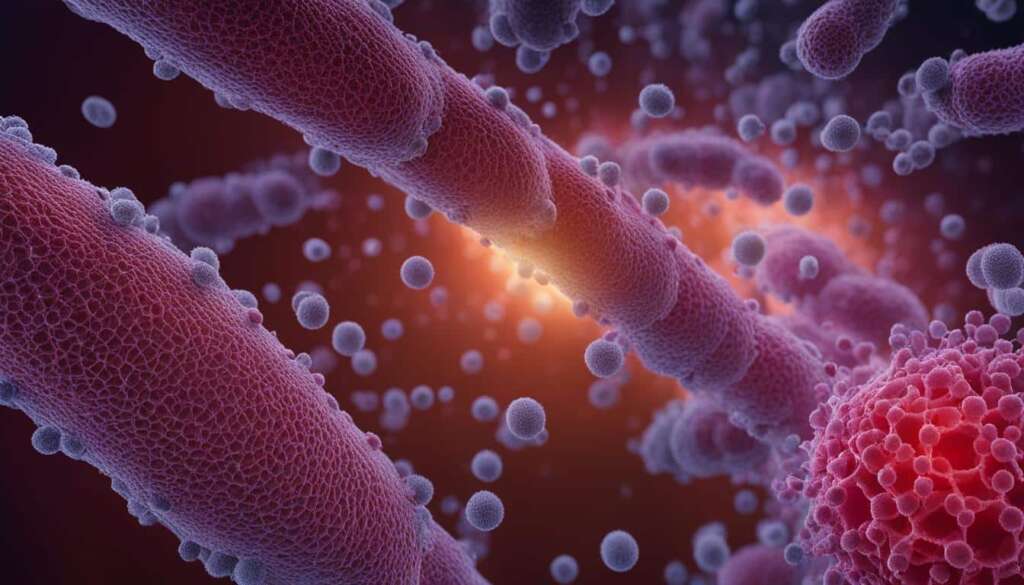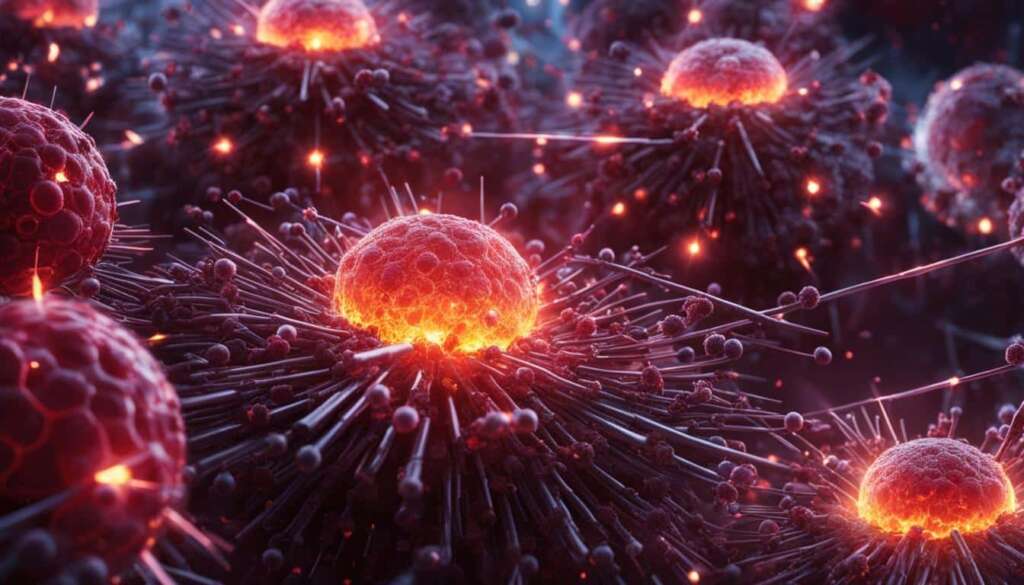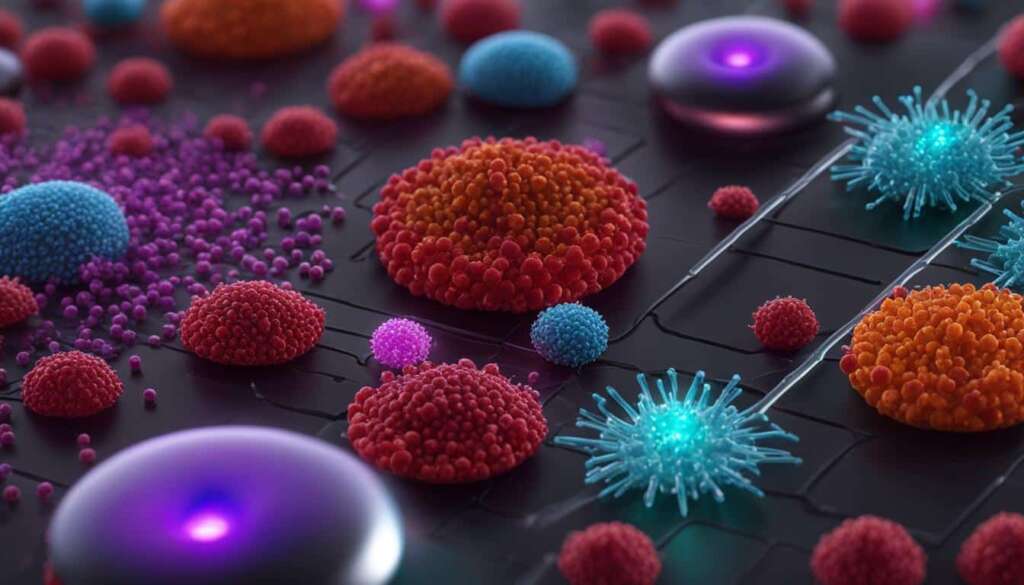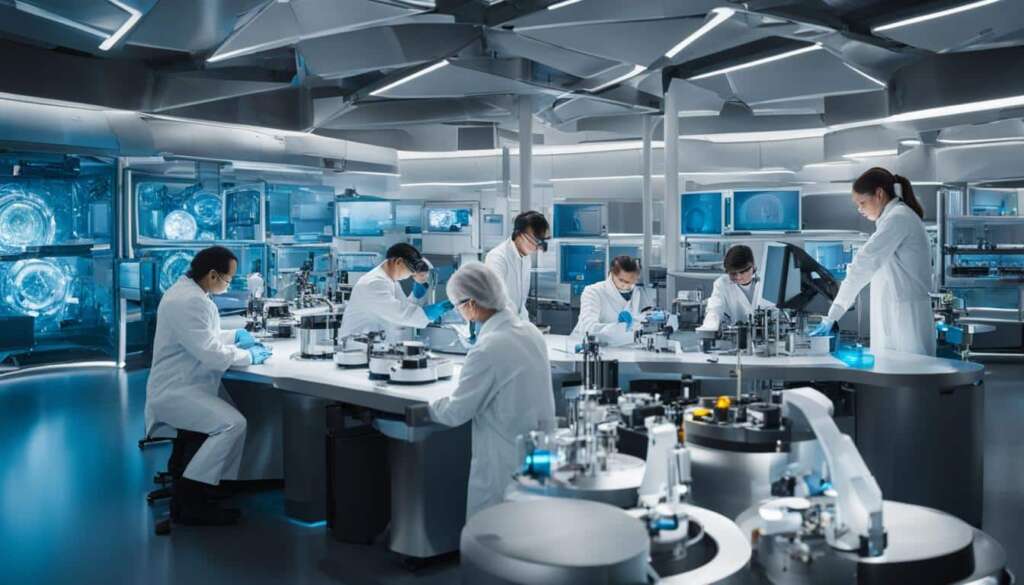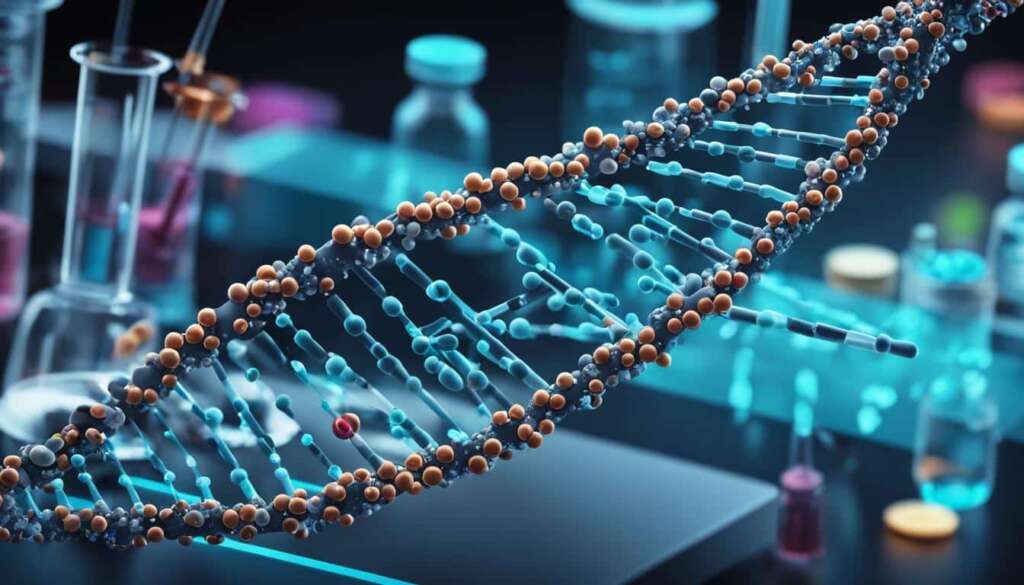Table of Contents
Nanotechnology has emerged as a promising field in medicine, with potential applications in drug delivery systems. Recent research in nanomedicine has focused on developing precise and targeted treatments for various diseases. This article explores the impact of drug delivery nanotechnology on patient care and the future of healthcare.
Key Takeaways:
- Drug delivery nanotechnology offers precise and targeted treatments for improved patient care.
- This emerging field has the potential to revolutionize healthcare by minimizing side effects and optimizing therapeutic efficacy.
- Nanotechnology-based drug delivery systems enable personalized medicine and improved patient outcomes.
- Challenges such as regulatory issues and safety concerns must be addressed for widespread adoption.
- Ongoing research is focused on developing innovative strategies and integrating nanotechnology with other technologies.
Nanotechnology in Medicine: A Comprehensive Overview
The field of nanomedicine encompasses a wide range of applications, including drug delivery systems. Nanotechnology-based drug delivery systems, such as liposomes, polymeric micelles, nanoparticles, dendrimers, and nanocrystals, have been developed to improve the efficacy and targeted delivery of therapeutic agents. These nanodevices can be designed to specifically target disease sites, delivering drugs in a controlled and precise manner.
Nanoparticles, one of the most commonly used nanodevices in drug delivery systems, are engineered to carry drugs to the desired location in the body. Their small size and unique properties enable them to navigate through biological barriers and reach the target site more effectively. This targeted approach improves the effectiveness of treatments while minimizing the dosage required, reducing the risk of side effects.
The Role of Nanoparticles in Drug Delivery
Nanoparticles have emerged as versatile carriers for drug delivery due to their tunable size, surface characteristics, and ability to encapsulate a wide range of therapeutic agents. These nanoscale particles can be designed to release the encapsulated drugs in a controlled manner, ensuring sustained release and prolonged therapeutic effect.
By encapsulating drugs into nanoparticles, we can overcome the limitations of conventional drug delivery systems. The small size allows nanoparticles to bypass the body’s defense mechanisms and accumulate at the target site, increasing drug concentration and minimizing exposure to healthy tissues.
In addition to targeted drug delivery, nanotechnology offers other advantages in medicine. Nanomaterials can improve the solubility and stability of poorly soluble drugs, enhancing their bioavailability and therapeutic efficacy. Moreover, these materials can be surface-modified to attach targeting ligands, allowing for precise targeting of specific cells or tissues.
Nanotechnology Advancements in Cancer Treatment
Cancer treatment is one area where nanomedicine has shown significant promise. The ability to deliver chemotherapeutic agents directly to cancer cells, while sparing healthy tissues, can greatly improve treatment outcomes and patient quality of life.
Nanoparticles can be engineered to selectively accumulate in tumor tissues through passive or active targeting mechanisms. Passive targeting takes advantage of the enhanced permeability and retention effect, which allows nanoparticles to accumulate in the leaky blood vessels surrounding tumors. Active targeting involves the attachment of ligands to the nanoparticle surface, allowing them to bind to receptors expressed on cancer cells, increasing specificity and uptake.
| Nanoparticle Type | Advantages | Applications |
|---|---|---|
| Liposomes | High drug-loading capacity, biocompatibility, and ability to encapsulate both hydrophilic and hydrophobic drugs. | Treatment of various cancers, such as breast, lung, and ovarian cancer. |
| Polymeric Micelles | Amphiphilic nature allows for efficient encapsulation of hydrophobic drugs and effective tumor penetration. | Targeted delivery of anticancer drugs, including paclitaxel and doxorubicin. |
| Nanoparticles | Small size enables passive accumulation in tumor tissues, while surface modification allows active targeting. | Delivery of chemotherapeutic agents, gene therapy, and photodynamic therapy. |
Nanotechnology-based drug delivery systems are not limited to cancer treatment but also find applications in other areas of medicine. From targeted drug delivery for neurodegenerative diseases to improved diagnostics through nanosensors, nanomedicine is poised to revolutionize healthcare and personalized medicine.
Advantages of Drug Delivery Nanotechnology
Drug delivery nanotechnology offers several advantages in the field of medicine. It allows for the precise delivery of therapeutic agents to specific target sites, minimizing off-target effects and reducing the dosage required.
Nanoscale drug delivery systems also have the potential to improve solubility, stability, and bioavailability of drugs, enhancing their therapeutic efficacy. This targeted approach ensures that the medication reaches the desired location in the body, increasing its effectiveness and minimizing any potential harm to healthy tissues.
Using drug delivery nanotechnology, we can achieve a high level of accuracy and specificity in delivering medications. This targeted approach enables healthcare professionals to tailor treatments to individual patients, improving overall patient care and outcomes.
One of the significant advantages of drug delivery nanotechnology is its ability to overcome biological barriers that hinder the efficacy of traditional drug delivery methods. Nanoparticles, liposomes, and other nanoscale carriers can bypass physiological obstacles, allowing medications to reach their intended targets more effectively.
Furthermore, nanotechnology-based drug delivery systems can enhance the stability and solubility of drugs that otherwise pose challenges in formulation. This improved formulation increases the bioavailability of medications, ensuring that a higher proportion of the drug reaches its target site.
The advantages of drug delivery nanotechnology extend beyond targeted treatments and precise drug delivery. These innovative systems have the potential to reduce the frequency of drug administration, minimize side effects, and improve patient compliance with medication regimens.
Overall, drug delivery nanotechnology opens up new possibilities for personalized medicine, transforming the way we approach treatment. By harnessing the advantages of nanotechnology, healthcare professionals can optimize therapeutic outcomes and improve patient care.
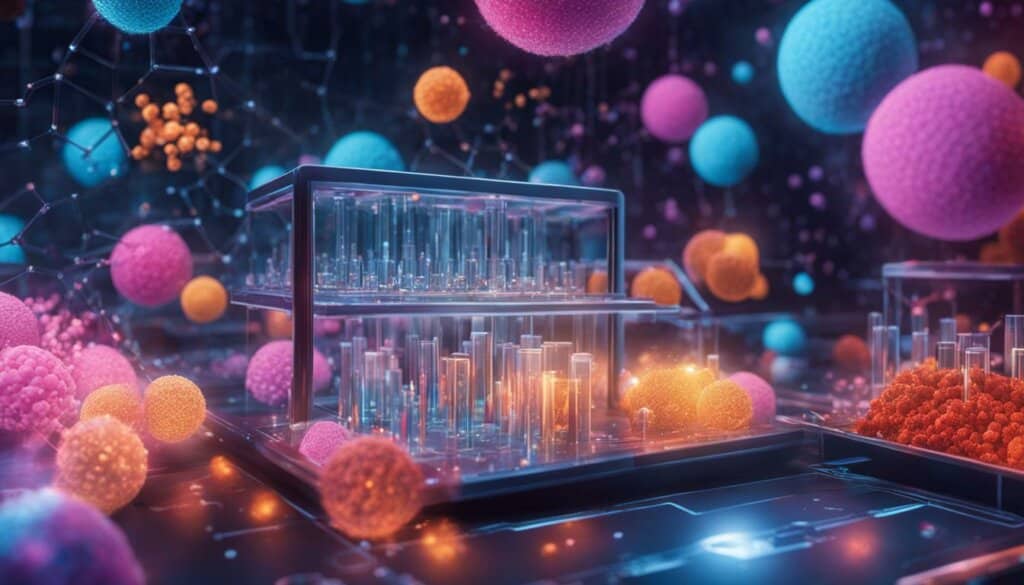
Applications of Drug Delivery Nanotechnology in Healthcare
Drug delivery nanotechnology holds significant potential in revolutionizing healthcare. Its applications span across various areas, including cancer treatment and diagnostics. Nanotechnology-based drug delivery systems have shown promise in improving the efficacy of chemotherapy while reducing the harsh side effects of treatment. Additionally, nanoparticles and nanosensors have paved the way for more accurate and efficient disease detection.
In cancer treatment, drug delivery nanotechnology plays a crucial role in enhancing the effectiveness of chemotherapy drugs. By encapsulating drugs within nanocarriers, targeted delivery to cancer cells can be achieved, while minimizing damage to healthy tissues. This targeted approach not only increases the treatment’s efficacy but also reduces the risk of adverse side effects.
Furthermore, in the field of diagnostics, nanotechnology offers transformative solutions. Nanoparticles can be engineered to carry diagnostic agents, enabling earlier and more accurate disease detection. These nanosensors are capable of identifying biomarkers or specific disease-related molecules, providing valuable diagnostic information that can aid in early intervention and improved patient outcomes.
Moreover, drug delivery nanotechnology has the potential to revolutionize the diagnosis and treatment of various other diseases. By leveraging the unique properties of nanomaterials, targeted delivery systems can be developed for a wide range of therapeutic agents, such as gene therapies and immunotherapies. This opens up possibilities for personalized and precise treatments in areas beyond cancer, including neurological disorders, cardiovascular diseases, and infectious diseases.
Key Advantages of Drug Delivery Nanotechnology in Healthcare:
- Enhanced efficacy and reduced side effects in cancer treatment
- Achievement of targeted drug delivery to specific cells or tissues
- Improved disease detection through nanosensors and nanoparticles
- Potential for personalized medicine and tailored treatments
- Opportunity for early intervention and improved patient outcomes
The use of drug delivery nanotechnology in healthcare applications holds immense promise. By harnessing the potential of nanomaterials and engineering precise delivery systems, healthcare providers can significantly enhance patient care and treatment outcomes. As research in this field continues to advance, we can expect further breakthroughs in diagnostics, therapy, and personalized medicine, revolutionizing the way we approach healthcare.
Challenges and Future Directions in Drug Delivery Nanotechnology
Despite the potential benefits, drug delivery nanotechnology faces various challenges that must be addressed for its widespread adoption. These challenges include regulatory issues, manufacturing scalability, and the need for a deeper understanding of the interactions between nanomaterials and biological systems.
“Efforts are being made to overcome these challenges and advance the clinical translation of nanotechnology-based drug delivery systems.”
Regulatory issues play a crucial role in the development and commercialization of nanotechnology-based drug delivery systems. The use of nanomaterials raises concerns about their potential impact on human health and the environment. Therefore, stringent guidelines and regulations are necessary to ensure the safety and efficacy of these innovative therapies.
Another significant challenge is the scalability of manufacturing processes. The production of nanoscale drug delivery systems requires precise control over the size, composition, and functionalization of nanoparticles or other nanocarriers. Scaling up these processes while maintaining their quality and integrity is a complex task that requires further research and development.
A deeper understanding of the interactions between nanomaterials and biological systems is also crucial for the successful translation of drug delivery nanotechnology into clinical applications. This includes investigating the fate and behavior of nanomaterials in the body, assessing their potential toxicity, and determining optimal dosing strategies.
Future directions:
- Advancing regulatory frameworks: Collaborative efforts between regulatory bodies, researchers, and industry stakeholders are needed to establish clear guidelines for the safe and efficient use of nanotechnology in drug delivery.
- Improving manufacturing processes: Continued research and innovation are necessary to develop scalable and cost-effective manufacturing methods for nanoscale drug delivery systems.
- Enhancing safety assessment: Comprehensive studies on the toxicity and long-term effects of nanomaterials are essential to ensure the development of safe nanotechnology-based therapies.
- Exploring novel delivery strategies: The development of innovative delivery platforms, such as stimuli-responsive nanocarriers and targeted nanorobots, holds great potential for improving drug delivery precision.
- Integrating nanotechnology with other cutting-edge technologies: The integration of nanotechnology with emerging fields like artificial intelligence and nanorobotics can lead to novel therapeutic approaches and personalized medicine.
Current Challenges in Drug Delivery Nanotechnology
| Challenges | Solutions |
|---|---|
| Regulatory issues | Establishing clear guidelines and collaboration between regulatory bodies, researchers, and industry stakeholders. |
| Manufacturing scalability | Continued research and innovation to develop scalable and cost-effective manufacturing methods. |
| Interactions with biological systems | Further understanding of nanomaterial behavior and toxicity through comprehensive studies. |
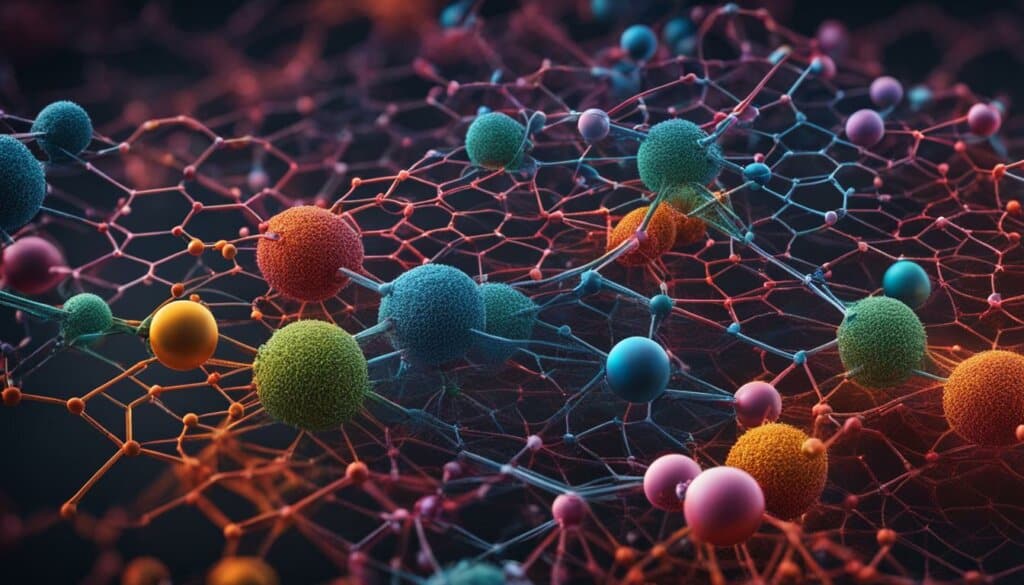
Safety and Ethical Considerations in Drug Delivery Nanotechnology
Safety is a critical aspect of drug delivery nanotechnology. The use of nanomaterials in medical applications raises concerns about their potential toxicity and long-term effects on human health. It is essential to carefully evaluate the safety considerations associated with drug delivery nanotechnology to ensure the well-being of patients.
“The safety of nanotechnology-based drug delivery systems is of paramount importance in healthcare. We need to thoroughly assess their potential risks and develop strict regulatory guidelines to protect patients.”
One of the key safety considerations in drug delivery nanotechnology is the potential toxicity of nanomaterials. Due to their small size and unique properties, nanomaterials may have different interactions with biological systems compared to conventional materials. It is crucial to conduct rigorous testing to assess the toxicity of nanomaterials and their potential impact on human health. Understanding the long-term effects of nanomaterials is vital to ensure patient safety and promote the responsible use of this technology.
Ethical implications also play a significant role in drug delivery nanotechnology. As medical advancements continue, patient privacy and informed consent become increasingly important. Patients have the right to know and understand the potential risks associated with nanotechnology-based treatments. Ensuring transparency and providing comprehensive information to patients is essential for fostering trust and ethical practice in drug delivery nanotechnology.
Ethical Implications
The ethical implications of drug delivery nanotechnology extend beyond patient privacy and informed consent. As nanomedicine evolves, it is crucial to consider the equitable access to these advanced treatments. Affordability and accessibility can pose challenges, and efforts must be made to ensure that the benefits of nanotechnology are available to all patients, regardless of their socioeconomic status.
Safety Guidelines and Regulations
Establishing comprehensive safety guidelines and regulatory frameworks is vital to ensure the ethical and responsible use of drug delivery nanotechnology. These guidelines should address safety assessment protocols, manufacturing standards, and the proper handling and disposal of nanomaterials. Collaboration between regulatory bodies, researchers, and healthcare professionals is essential to develop effective regulations that prioritize patient safety and encourage innovation in drug delivery nanotechnology.
Overall, safety considerations and ethical implications are integral aspects of drug delivery nanotechnology. By prioritizing patient well-being, conducting thorough safety assessments, and implementing robust regulatory frameworks, we can harness the potential of nanotechnology in medicine while upholding the highest standards of patient care and ethical practice.
Current Research and Innovations in Drug Delivery Nanotechnology
Ongoing research in drug delivery nanotechnology is focused on developing new strategies and innovations for targeted therapies. This field is expanding rapidly, driven by the potential to revolutionize patient care and improve treatment outcomes. By harnessing the power of nanotechnology, scientists and researchers are exploring various avenues to enhance the precision, efficiency, and effectiveness of drug delivery systems.
Nanobiosensors for Real-time Monitoring
One area of current research involves the development of nanobiosensors for real-time monitoring of drug delivery. These nanoscale devices can provide valuable insights into drug distribution, metabolism, and efficacy within the body. By integrating sensors with drug delivery systems, healthcare professionals can optimize treatment regimens and ensure targeted therapies are successfully reaching their intended destinations.
Smart Drug Delivery Systems
The advancement of smart drug delivery systems is another exciting area of innovation. These systems are designed to respond to physiological cues, ensuring optimal drug release and delivery based on specific patient needs. By incorporating sensors, actuators, and feedback mechanisms, smart drug delivery systems have the potential to revolutionize personalized medicine, providing tailored treatments and improving patient outcomes.
Integration with Emerging Technologies
Nanotechnology is also being integrated with other emerging technologies to further enhance targeted therapies. Artificial intelligence (AI) and machine learning algorithms are being utilized to analyze vast amounts of data and optimize drug delivery strategies. Nanorobotics, on the other hand, offers the potential for precise manipulation and delivery of therapeutic agents at the nanoscale. These interdisciplinary approaches are driving forward the frontiers of drug delivery nanotechnology and paving the way for novel treatment modalities.
As current research progresses, it is clear that drug delivery nanotechnology holds immense promise for the development of targeted therapies. By leveraging nanobiosensors, smart drug delivery systems, and the integration with other emerging technologies, researchers are bringing us closer to a future where precision medicine becomes a reality, revolutionizing patient care and improving treatment outcomes.
The Future of Healthcare: Embracing Drug Delivery Nanotechnology
Drug delivery nanotechnology holds immense potential in revolutionizing healthcare by enabling personalized medicine and significantly improving patient outcomes. Through the development of precise and targeted treatments, nanotechnology-based drug delivery systems offer the ability to minimize side effects and optimize therapeutic efficacy, ushering in a new era of patient-centric care.
One of the key advantages of drug delivery nanotechnology is its ability to deliver medications directly to the affected areas or cells in the body, avoiding unnecessary exposure to healthy tissues. By enhancing the delivery of therapeutic agents, nanotechnology-based systems can improve treatment effectiveness and decrease the dosage required, reducing the risk of adverse reactions. This targeted approach not only enhances patient safety but also enhances treatment outcomes.
Furthermore, drug delivery nanotechnology enables the development of personalized medicine, tailoring treatments to individual patients. With nanotechnology-based drug delivery systems, healthcare professionals can customize treatment plans based on a patient’s specific needs, genetic makeup, and medical history. This personalized approach ensures that patients receive the most effective treatments, leading to improved outcomes and quality of life.
The integration of drug delivery nanotechnology into healthcare holds promise across various medical specialties. For instance, in cancer treatment, nanotechnology allows for the delivery of chemotherapy directly to tumor sites, enhancing the efficacy of treatment while minimizing damage to healthy tissues. Additionally, nanotechnology-based diagnostic tools, such as nanoparticles and nanosensors, enable more accurate and efficient disease detection, enabling early intervention and improved prognosis.
“Drug delivery nanotechnology has the potential to transform healthcare by providing personalized and targeted treatments, improving patient outcomes and minimizing side effects.” – Dr. Emma Thompson, Nanomedicine Researcher
The Role of Personalized Medicine
The future of healthcare lies in personalized medicine, a paradigm shift from one-size-fits-all treatments to patient-specific care. Drug delivery nanotechnology plays a crucial role in this transformation by enabling the design and delivery of treatments tailored to individual patients. By harnessing the power of nanotechnology, healthcare providers can optimize treatment outcomes, enhance patient satisfaction, and ultimately improve overall healthcare effectiveness.
Improved Patient Outcomes
With the integration of drug delivery nanotechnology, patient outcomes can be significantly improved. The precise delivery of medications to targeted areas enhances treatment efficacy, leading to better symptom management and disease control. Moreover, personalized medicine ensures that patients receive the right treatment at the right time, maximizing therapeutic benefits and minimizing the risk of adverse reactions.
Advantages of Drug Delivery Nanotechnology in Healthcare
| Advantages of Drug Delivery Nanotechnology |
|---|
| Targeted delivery of therapeutic agents |
| Minimization of off-target effects |
| Reduced dosage requirements |
| Enhanced treatment efficacy |
| Improved patient safety |
| Customization of treatments based on individual patients |
By embracing drug delivery nanotechnology, healthcare professionals can unlock the full potential of personalized medicine, leading to improved patient outcomes and a more effective healthcare system. As research and innovation in nanotechnology continue to advance, the future of healthcare holds remarkable promise for the development of tailored treatments that address the specific needs and characteristics of each individual patient.

Conclusion
The field of drug delivery nanotechnology holds immense potential in transforming patient care, offering precise and targeted treatments for various diseases. Through the development of improved drug delivery systems, nanotechnology has the ability to enhance treatment efficacy while minimizing side effects. This promising technology paves the way for a future of healthcare that embraces personalized medicine and improved patient outcomes.
By overcoming the challenges associated with drug delivery nanotechnology, such as regulatory issues and manufacturing scalability, we can unlock its full potential and revolutionize patient care. It is crucial to address the ethical considerations surrounding the use of nanomaterials in medicine, ensuring patient safety and privacy. Rigorous testing and adherence to regulatory guidelines are essential in harnessing the benefits of nanotechnology while mitigating potential risks.
Continued research and innovation in drug delivery nanotechnology are crucial to advancing the field. By integrating nanotechnology with other emerging technologies, such as artificial intelligence and nanorobotics, we can explore new avenues for targeted therapies and real-time monitoring of drug delivery. Embracing these advancements in healthcare will enable the development of precise and tailored treatments, ultimately improving patient care and shaping the future of medicine.
FAQ
What is drug delivery nanotechnology?
Drug delivery nanotechnology refers to the use of nanoscale materials and devices to deliver therapeutic agents in a precise and targeted manner to specific sites in the body.
What are the advantages of drug delivery nanotechnology?
Drug delivery nanotechnology offers several advantages, including the precise delivery of therapeutic agents to specific target sites, minimization of off-target effects, reduction in required dosage, and improvements in drug solubility, stability, and bioavailability.
In which areas of healthcare is drug delivery nanotechnology being applied?
Drug delivery nanotechnology is being applied in various areas of healthcare, including cancer treatment, diagnostics, and targeted therapies for different diseases.
What are the challenges and future directions in drug delivery nanotechnology?
Challenges in drug delivery nanotechnology include regulatory issues, manufacturing scalability, and the need for a deeper understanding of the interactions between nanomaterials and biological systems. Ongoing research is focused on overcoming these challenges and advancing the clinical translation of nanotechnology-based drug delivery systems.
What are the safety and ethical considerations in drug delivery nanotechnology?
Safety considerations in drug delivery nanotechnology involve addressing potential toxicity and long-term effects of nanomaterials on human health. Ethical implications include patient privacy and informed consent. Rigorous testing and regulatory guidelines are crucial to ensure the safe and ethical use of nanotechnology in medicine.
What are the current research and innovations in drug delivery nanotechnology?
Current research in drug delivery nanotechnology is focused on developing new strategies and innovations, such as nanobiosensors for real-time monitoring of drug delivery, smart drug delivery systems that can respond to physiological cues, and integration with emerging technologies like artificial intelligence and nanorobotics.
How does drug delivery nanotechnology contribute to the future of healthcare?
Drug delivery nanotechnology has the potential to revolutionize healthcare by enabling personalized medicine and improving patient outcomes. By developing precise and targeted treatments, nanotechnology-based drug delivery systems can minimize side effects and optimize therapeutic efficacy.
What are the potential benefits of drug delivery nanotechnology?
The potential benefits of drug delivery nanotechnology include improved drug delivery systems, enhanced efficacy of treatments, and reduced side effects for patients.


